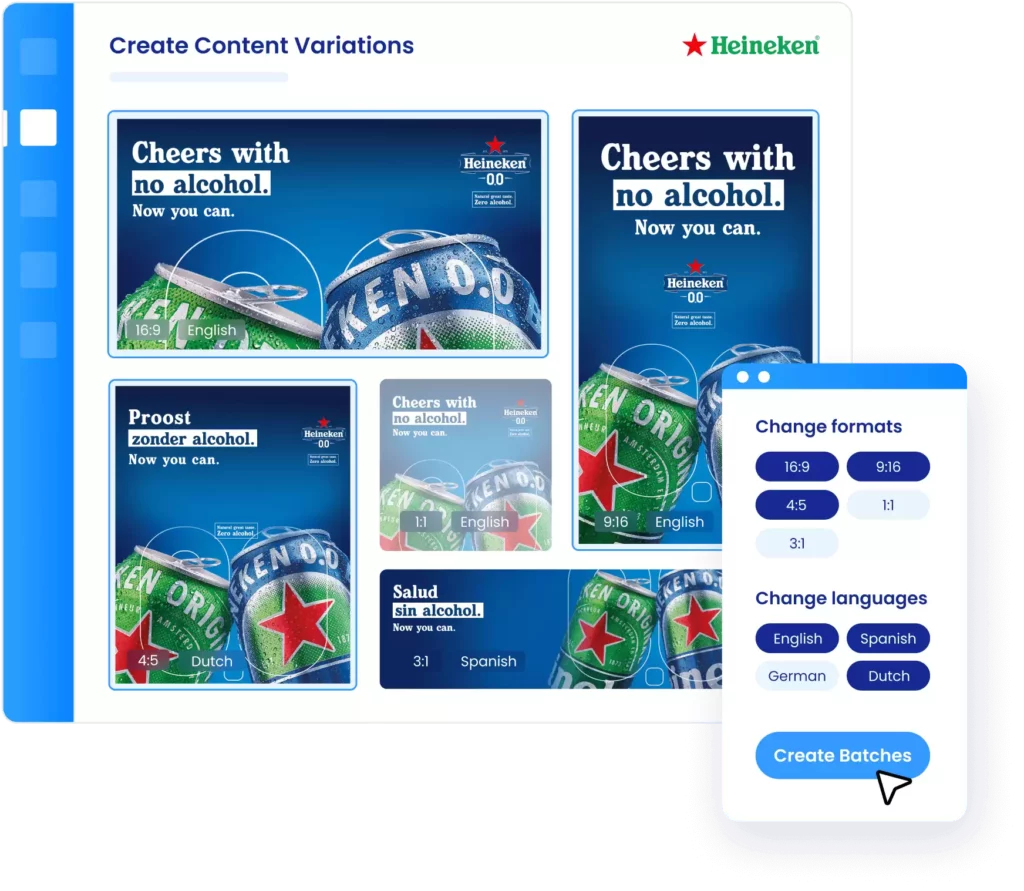In today’s digital world, marketers face the challenge of producing a vast amount of content quickly while maintaining quality and consistency. Did you know that according to a recent study, 60% of marketers feel pressured to create more content at a faster pace? Creative Automation is a game-changer in this scenario, helping brands streamline their content creation processes efficiently. This guide will cover what Creative Automation is, its benefits, and how to effectively implement it in your marketing strategy.
What is Creative Automation?
Creative Automation refers to the use of technology to automate the creation and modification of marketing content. This includes adapting digital assets like banners and videos to fit various formats, sizes, and audience segments without manually adjusting each one. By leveraging Creative Automation, brands can speed up production, reduce repetitive tasks, and improve overall workflow efficiency.
Read more in our blog “What is Creative Automation?”.
Benefits of Creative Automation
Creative Automation is revolutionizing how brands manage their content production, offering a range of benefits that enhance efficiency, maintain brand consistency, and drive cost savings. Here’s how Creative Automation can transform your marketing strategy:
1. Enhanced Efficiency and Speed
Streamlining Creative Production Workflows
Creative Automation centralizes and simplifies creative production workflows. By utilizing dynamic templates you can rapidly manage, review, and iterate on creative assets. This centralization minimizes the manual effort involved in creating and adapting content, leading to more streamlined and efficient workflows.
For example, with Creative Automation, teams can easily update and modify digital assets, such as banners and videos, without the need for extensive manual intervention. This means that designers and marketers can focus more on strategic tasks and less on repetitive work.
Reducing Time-to-Market
Speed is crucial in today’s fast-paced marketing environment. Creative Automation enables quicker turnaround times for content production, allowing brands to respond swiftly to market trends and consumer demands. By automating repetitive tasks, brands can accelerate their time-to-market, ensuring that their campaigns are timely and relevant.
Learn more about how to enhance efficiency with Creative Automation in our article, “Reducing Creative Turnaround Time”.
Preparing for Peak Moments
Creative Automation is especially valuable during peak periods, such as holiday seasons, when demand for high-quality, diverse content spikes. By automating content production, brands can efficiently manage large volumes of creative assets and ensure timely delivery. This preparation helps brands stay competitive and effectively engage with consumers during critical times.
Read about how to prepare for peak moments with creative automation in our article, “Tackling the Holiday Rush with Creative Automation”.

2. Improved Brand Consistency
Maintaining brand consistency across multiple markets and channels can be challenging. Creative Automation helps address this by providing centralised control over brand guidelines and templates. This ensures that all content variations adhere to the same brand standards, reducing the risk of inconsistency and brand dilution.
Centralized Brand Governance
Centralized governance through Creative Automation platforms allows teams to manage and review creative assets from a single location, ensuring that every piece of content aligns with the brand’s visual identity and messaging.
Maintaining Consistency Across Channels and Markets
Creative Automation facilitates consistent branding across diverse channels and markets. By using dynamic templates, you can easily adapt content to different formats, languages, and regional preferences while maintaining a cohesive brand identity.
This approach ensures that your marketing materials are not only tailored to local needs but also uphold a unified brand message globally.
For more on ensuring brand compliance, read our post about Brand Consistency.
3. Cost-Effectiveness
Reducing Manual Work and Outsourcing Costs
One of the significant advantages of Creative Automation is its cost-effectiveness. By automating repetitive tasks, you reduce the need for manual work and outsourcing, leading to substantial cost savings. Creative Automation tools enable teams to handle more tasks in-house, eliminating the need for expensive external agencies.
Maximizing Resource Utilization
Creative Automation optimizes resource use by freeing up time for creative teams to focus on high-level strategic tasks. Instead of spending time on manual adaptations, teams can use their skills for more impactful work, such as conceptualizing new campaigns and exploring innovative strategies.
See how to maximize resource utilization in our post, “Mastering ROAS: Strategies for positive Return on Ad Spend”.
4. Personalization and Localization
Creating Relevant Content for Diverse Audiences
In a global marketplace, delivering personalized content to various audience segments is essential. Creative Automation allows for the creation of localised and personalised content that resonates with different demographics. By automating the adaptation of content to suit various regional and audience-specific needs, brands can enhance engagement and relevance.
Read more about content localization in our blog about Effortless Localization.
Leveraging Data for Personalised Experiences
Creative Automation leverages data to drive personalized content experiences. By integrating data sources with dynamic templates, you can generate highly customized content based on audience preferences and behaviours. This data-driven approach ensures that your content is not only relevant but also optimized for maximum impact.
Explore how data-driven personalization can improve your content strategy, for example in peak seasons, in our blog, “Tackling the Holiday Rush with Creative Automation”.
5. Optimization and Testing
A/B Testing and Iteration
Creative Automation supports A/B and multivariate testing by enabling the rapid creation and testing of different content versions. This iterative approach helps identify which variations perform best, allowing for continuous optimization and improvement of your marketing materials.
Data-Driven Decision Making
Data plays a crucial role in optimising content performance. Creative Automation platforms provide insights into how different content variations perform, enabling data-driven decision-making. By analyzing performance metrics, you can make informed adjustments and enhance the effectiveness of your marketing campaigns.
Want to see a practical example? See how Albert Heijn uses data for better decision-making in our blog, “Optimizing Digital In-Store Advertising with Creative Automation”.
How Creative Automation Works
- Creating a Strong Base Digital Creative Asset or Master Template
- Develop a versatile master template that can serve as the foundation for various content formats and platforms.
- Customizing the Base Asset into Dynamic, Reusable Templates
- Adapt the master template into dynamic templates that can be easily modified to suit different needs and preferences.
- Linking Data to Dynamic Elements in the Templates
- Integrate data sources to personalize content, ensuring relevance and engagement.
- Generating Numerous Versions Quickly
- Utilize automation tools to produce multiple content variations swiftly, saving time and resources.
- Sharing, Using, or Split-Testing the Versions as Needed
- Distribute the content across channels, use it in campaigns, or conduct A/B testing to optimise performance.

How To Implement Creative Automation
1. Identify Your Creative Automation Needs
Assess your organization’s needs by auditing existing content, analyzing past and upcoming campaigns, and evaluating your current workflow. Set clear metrics to measure success and guide your implementation.
2. Embrace Template-Thinking
Templates standardize design elements, ensuring consistency and efficiency. Transitioning to a template-based approach helps streamline production and focus on creative tasks. Utilize tools like Adobe After Effects for template creation.
3. Choose the Right Tool for You
Select a tool that integrates with your systems, offers flexible template creation, and supports various input and output options. Ensure robust customer support and consider tools with trials to test features.
4. Getting Started with Implementation
Begin with a pilot project to test the tool and train your team. Monitor performance, make adjustments as needed, and avoid common pitfalls by starting small and refining your approach.
For further elaborations and final tips, see our blog “Creative Automation Made Simple: A Step-by-Step Guide”.
Creative Automation In Action
Do you want to see Creative Automation in practice? Our experts Rogier Ros and Simon Blok talk about how Creative Automation support brand consistency for global brands and give practical examples. Watch it now!
Want to read more case studies?
Read our Heineken case study here.
Read how BMW maintained consistency & compliance over multiple brands here.
Find out how Co-op transformed their creative production through one MarTech system.
Conclusion
Creative Automation is not just a trend but a necessity in the modern marketing landscape. By embracing this technology, brands can significantly enhance their efficiency, seamlessly scale their content, ensure consistent and high-quality content across all platforms, and ultimately drive better results. For global enterprises, Creative Automation offers the tools and capabilities to stay competitive and relevant in a fast-paced digital world.
Want to receive weekly tips on Creative Automation?
Then make to follow our expert, Rogier Ros, on LinkedIn! He shares his best insights, views on trends and example from practice on a weekly basis. Make sure to not miss it!
